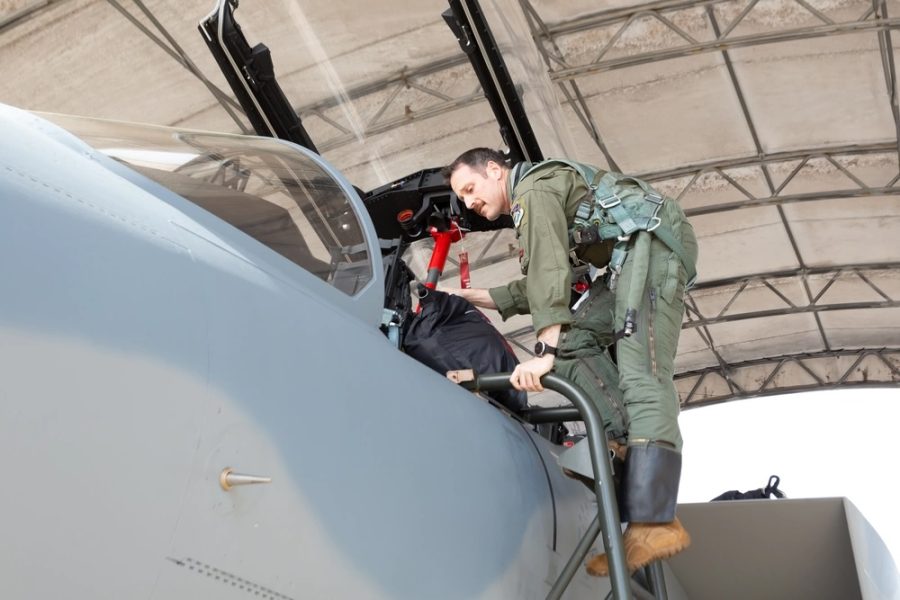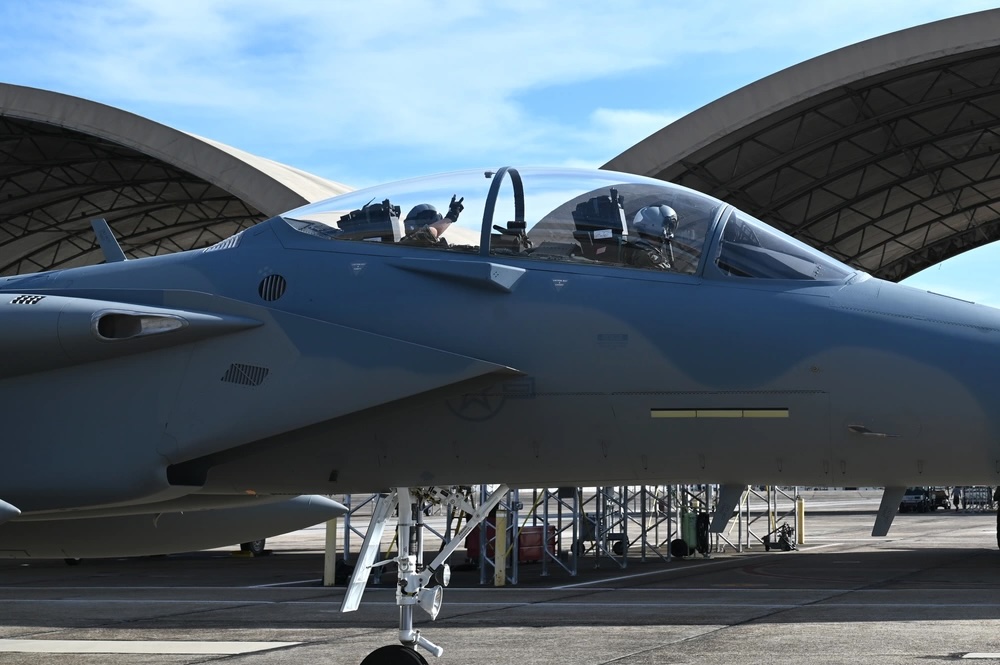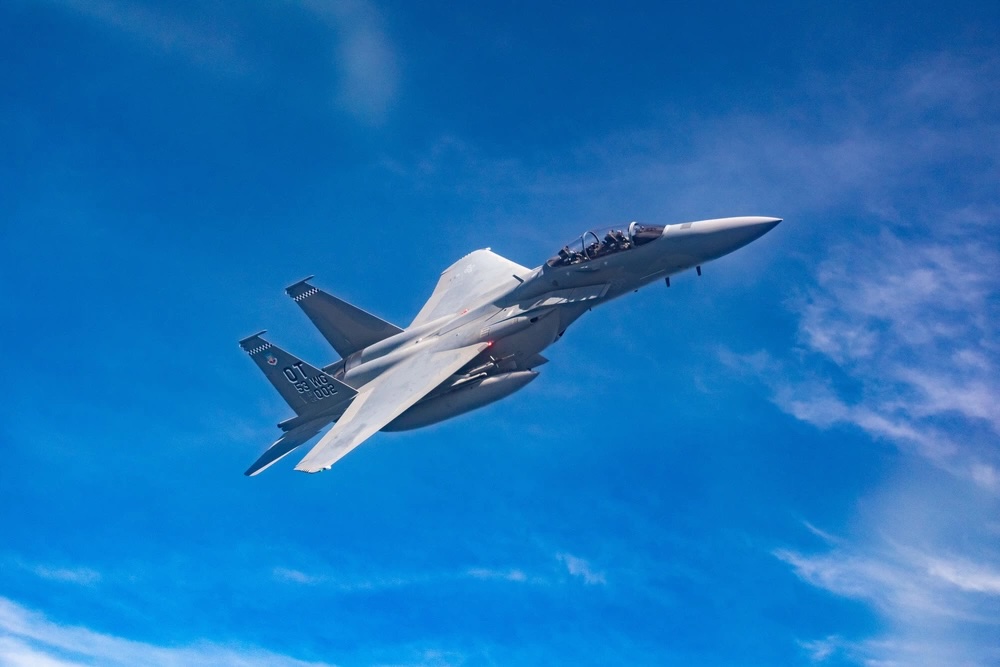David Roza

Pilots from the Oregon Air National Guard’s 142nd Wing—poised to be the first operational unit for the F-15EX later this year—gave the new fighter rave reviews after becoming the first members of their unit to fly the aircraft at a training course in Eglin Air Force Base, Fla. earlier this month.
“My impression of the F- 15EX after flying it for the first time was that it is an awesome, awesome aircraft,” Lt. Col. Joel “Thermo” Thesing, said in a press release published March 15.
A member of Oregon’s 123rd Fighter Squadron, Thesing currently pilots the F-15C, the aging single-seat air superiority fighter flown by Air National Guard units in Oregon, California, Florida, Louisiana, and Massachusetts. Oregon’s Portland-based 142nd Wing expects to switch to the F-15EX starting summer. Dubbed the Eagle II, the two-seat EX promises higher speed, longer range, increased payload, and more advanced technology than previous variants. It didn’t take Thesing long to notice the improvements.
“The engines feel like they have a lot more power than those in the C-model, and the radar and avionics are a generational improvement over the F-15C as well,” he said in the release.

123rd Fighter Squadron pilot, Lt. Col. Joel “Thermo” Thesing, along with 85th Test and Evaluation Squadron pilot, Maj. Scott “Hoosier” Addy (back seat), taxis the runway in an F-15 EX at Eglin Air Force Base, Fla. on March 7, 2024.
Thesing was among five F-15C instructor pilots from Oregon to attend the two-week training course, which started the first week of March. They are not the first Air National Guard pilots to fly the F-15EX, but they are the first from the upcoming first operational unit of the EX, 142nd spokesperson Steve Conklin told Air & Space Forces Magazine. Training a C-model pilot to fly the EX takes only about two weeks, he said.
The plan is for the instructor pilots to take their knowledge back to Portland to train the rest of the wing as it transitions to the F-15EX.
“We are excited to be at the forefront of this acquisition and lead as an Air National Guard unit,” Conklin said. “Our Airmen are fully capable and enthused to be trailblazers for the Air Force in the State of Oregon.”
Historically, the Oregon Air National Guard’s 173rd Fighter Wing hosted F-15C/D training at Klamath Falls, Ore., but that wing is due to become an F-35 formal training unit. Seymour Johnson Air Force Base, N.C., will take over all basic F-15 training in early 2026, with follow-on training on graduates’ specific model at their first unit.
One of the changes pilots must adapt to in the EX is a fly-by-wire system, where electrical wires replace the usual cables in relaying a pilot’s commands to the aircraft. Another change is the cockpit display: the EX does away with old-school small screens and dials in favor of large touchscreen displays similar to those found in an F-35. One former F-15E pilot was excited about the new tech.
“When I look at this thing it makes me salivate a little bit,” former Air Force Maj. Ryan Bodenheimer said on his YouTube channel in 2023. “The F-15E was great but the screens on that thing were small, they needed updating,” and they were difficult to see depending on the outside light.

An F-15EX Eagle II from the 85th Test and Evaluation Squadron, 53rd Wing, takes flight for the first time out of Eglin Air Force Base, Fla., April 26, 2021.
Bodenheimer recalled weapons systems officers, who ride in the backseat of the F-15E, covering their helmets and displays with maps so they could operate the navigation and targeting pods through “this little tiny soda straw screen.”
“This is going to be a huge force multiplier because it increases your situational awareness by allowing you to just kind of breathe and see what’s going on, without having the anxiety of thinking ‘OK, I’ve got to be so careful because I could miss the tiniest little green blip on my screen that could be something that I needed to see,’” he said.
But old habits die hard, and Thesing said flying the EX will take some adjustment.
“The initial work will take a lot of studying and practice to get the basics of flying the aircraft down and learning its systems, and that process has a steep learning curve, and never really ends for as long as you’re a pilot,” he said in the release. “That being said, I look forward to when the focus can shift from how to fly the EX, to how to employ it tactically.”
The Air Force currently has four F-15EXs, all of which are being tested at Eglin. The service initially planned to purchase 144 as an advanced fourth-generation replacement for the old F-15C/Ds. But now the service says it will cap the fleet at 98. At one time, the Air Force expected to buy upwards of 180 F-15EXs.
No comments:
Post a Comment